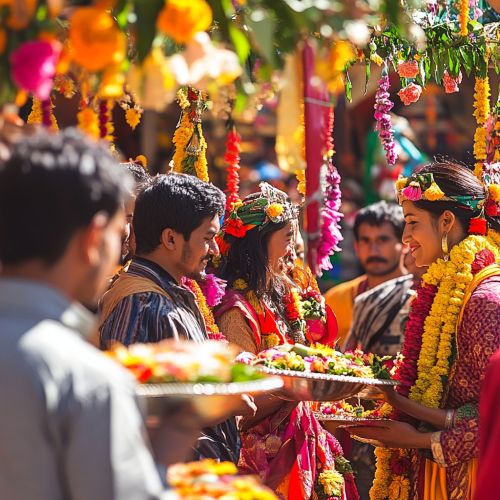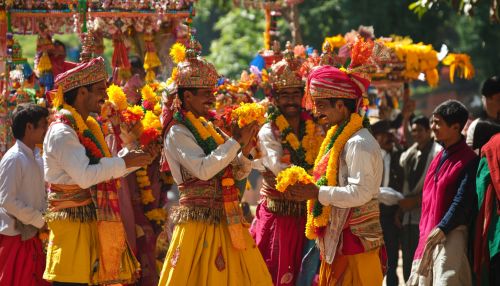Newar: Difference between revisions
(Created page with "== Introduction == The Newar, also known as the Newa, are the indigenous people of the Kathmandu Valley in Nepal. They are known for their rich cultural heritage, intricate craftsmanship, and vibrant festivals. The Newar community is a unique blend of various ethnicities and cultures, which have evolved over centuries to create a distinct identity. This article delves into the history, culture, language, religion, and socio-economic aspects of the Newar people. == Histo...") |
No edit summary |
||
| Line 74: | Line 74: | ||
* [[Buddha Jayanti]] | * [[Buddha Jayanti]] | ||
[[Image:Detail-98077.jpg|thumb|center|Newar people celebrating a traditional festival with colorful attire and decorations.|class=only_on_mobile]] | |||
[[Image:Detail-98078.jpg|thumb|center|Newar people celebrating a traditional festival with colorful attire and decorations.|class=only_on_desktop]] | |||
== References == | == References == | ||
Latest revision as of 13:30, 23 September 2024
Introduction
The Newar, also known as the Newa, are the indigenous people of the Kathmandu Valley in Nepal. They are known for their rich cultural heritage, intricate craftsmanship, and vibrant festivals. The Newar community is a unique blend of various ethnicities and cultures, which have evolved over centuries to create a distinct identity. This article delves into the history, culture, language, religion, and socio-economic aspects of the Newar people.
History
The history of the Newar people is deeply intertwined with the history of the Kathmandu Valley. Archaeological evidence suggests that the valley has been inhabited since ancient times, with the earliest settlers believed to be the Kirat people. The Newar civilization began to take shape around the 4th century AD, during the Licchavi period. The Licchavi dynasty, which ruled from the 4th to the 9th century, played a significant role in shaping the cultural and architectural landscape of the valley.
The Malla period, which lasted from the 12th to the 18th century, is considered the golden age of Newar civilization. During this time, the valley was divided into several small kingdoms, each ruled by a Malla king. The Malla rulers were great patrons of art, architecture, and literature, leading to a flourishing of Newar culture. The construction of iconic structures such as the Kathmandu Durbar Square, Patan Durbar Square, and Bhaktapur Durbar Square took place during this period.
The unification of Nepal by King Prithvi Narayan Shah in the 18th century marked the end of the Malla period and the beginning of the Shah dynasty. Despite the political changes, the Newar people continued to preserve their cultural heritage and traditions.
Language
The Newar people speak the Newar language, also known as Nepal Bhasa. It is a Sino-Tibetan language with a rich literary tradition. The earliest known inscriptions in Nepal Bhasa date back to the Licchavi period. The language has evolved over time, incorporating elements from Sanskrit, Tibetan, and other languages.
Nepal Bhasa has several dialects, which vary depending on the region and community. The Kathmandu dialect is considered the standard form of the language. Despite the influence of Nepali and English, Nepal Bhasa remains an integral part of Newar identity and culture.
Religion
The Newar people practice a unique blend of Hinduism and Buddhism. This syncretic tradition is known as Newar Buddhism or Newar Hinduism. The two religions coexist harmoniously, with many Newar families practicing both.
Hindu Newars primarily worship deities such as Kumari, Taleju Bhawani, and Bhairava. They celebrate festivals like Dashain, Tihar, and Indra Jatra. Buddhist Newars follow the Vajrayana tradition and revere deities such as Avalokiteshvara, Manjushri, and Vajrayogini. They celebrate festivals like Buddha Jayanti, Gunla, and Samyak.
The Newar community is also known for its unique rituals and ceremonies, such as the Ihi (bel marriage) and Janku (celebration of longevity). These rituals reflect the deep spiritual and cultural significance of religion in Newar society.
Art and Architecture
Newar art and architecture are renowned for their intricate craftsmanship and aesthetic beauty. The Newar people have made significant contributions to the artistic heritage of Nepal, particularly in the fields of sculpture, painting, and architecture.
Newar architecture is characterized by its elaborate woodwork, brickwork, and metalwork. The traditional Newar house, known as a pati, is a multi-storied structure with a central courtyard. The pagoda style, which is a hallmark of Newar architecture, can be seen in the numerous temples and stupas in the Kathmandu Valley.
Newar sculpture and painting are equally impressive. The Newar artisans are skilled in creating detailed stone and metal sculptures of deities and mythical figures. Thangka painting, a traditional form of Buddhist art, is also a significant aspect of Newar culture.
Festivals
The Newar people celebrate a wide range of festivals throughout the year, reflecting their rich cultural and religious heritage. These festivals are marked by elaborate rituals, processions, and feasts.
One of the most important Newar festivals is Indra Jatra, which is celebrated in honor of the god Indra. The festival features the Kumari Jatra, a procession of the living goddess Kumari, and various traditional dances and performances.
Another significant festival is Bisket Jatra, which marks the Nepali New Year. The festival is celebrated with the erection of a ceremonial pole, chariot processions, and various cultural activities.
Other notable Newar festivals include Mha Puja (worship of the self), Yomari Punhi (celebration of the harvest), and Gai Jatra (festival of cows). These festivals provide an opportunity for the Newar community to come together and celebrate their cultural heritage.
Cuisine
Newar cuisine is known for its variety and richness. It includes a wide range of dishes made from rice, lentils, vegetables, and meat. Some of the most popular Newar dishes are choila (spiced grilled meat), baji (beaten rice), wo (lentil pancake), and yomari (sweet dumpling).
Newar cuisine also includes various traditional alcoholic beverages, such as aela (rice beer) and thon (millet beer). These beverages are an integral part of Newar rituals and celebrations.
Social Structure
The Newar community has a complex social structure, which is traditionally divided into various castes and sub-castes. The caste system among the Newars is unique and differs from the Hindu caste system. It includes both Hindu and Buddhist castes, with each caste having its own distinct customs and traditions.
The Newar caste system is broadly divided into two main groups: the Shrestha (nobles) and the Jyapu (farmers). The Shrestha caste includes various sub-castes, such as the Rajopadhyaya Brahmins, Chathariya, and Panchthariya. The Jyapu caste is primarily engaged in agriculture and includes sub-castes like the Maharjan and Dangol.
Despite the traditional caste divisions, the Newar community is known for its social cohesion and mutual respect among different castes.
Economy
The Newar people have traditionally been engaged in various occupations, including agriculture, trade, and craftsmanship. The fertile land of the Kathmandu Valley has allowed the Newars to practice intensive agriculture, growing crops such as rice, wheat, and vegetables.
Trade has also been an important aspect of the Newar economy. The strategic location of the Kathmandu Valley along ancient trade routes facilitated the growth of commerce and trade. The Newar merchants, known as Sahu, played a significant role in the trade between Tibet and India.
Craftsmanship is another key aspect of the Newar economy. The Newar artisans are renowned for their skills in metalwork, woodwork, and pottery. The traditional crafts of the Newar people continue to thrive, contributing to the local economy and cultural heritage.
Education
Education has always been valued in Newar society. The Newar people have a long tradition of learning and scholarship, with many Newar scholars making significant contributions to literature, philosophy, and science.
In modern times, the Newar community has made significant strides in education. There are numerous schools and colleges in the Kathmandu Valley that cater to the educational needs of the Newar people. The emphasis on education has led to a high literacy rate among the Newars, with many pursuing higher education and professional careers.
Challenges and Preservation
Despite their rich cultural heritage, the Newar people face several challenges in preserving their traditions and identity. Rapid urbanization and modernization have led to the erosion of traditional practices and lifestyles. The younger generation is increasingly adopting modern ways of life, leading to a decline in the use of Nepal Bhasa and traditional customs.
Efforts are being made to preserve and promote Newar culture. Various organizations and community groups are working to document and revive traditional practices, languages, and crafts. Festivals and cultural events are also being organized to raise awareness and appreciation of Newar heritage.
See Also


